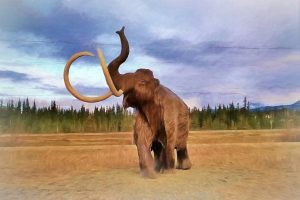
A biotech company that is proposing to clone woolly mammoths for reintroduction into the wild has recently received a 60 million dollar boost to the project’s funding, a cash injection that the company says will enable them to produce their first mammoth in just four years, to walk the Earth for the first time since the species went extinct nearly 10,000 years ago.
Dallas-based Colossal Biosciences reports that they are currently working on editing woolly mammoth genes with the goal of resurrecting the currently-extinct pachyderm for reintroduction into their former habitat in Russia’s Arctic region, although that location may change in light of the current political situation regarding the country. The company describes their proposed mammoths as “a cold-resistant elephant with all of the core biological traits of the Woolly Mammoth,” according to Colossal’s website, and hope that the creatures’ reintroduction into the Arctic will help combat climate change, and with the help of this new funding the first clones could be produced by 2027.
“In the minds of many, this creature is gone forever,” according to the company. “But not in the minds of our scientists, nor the labs of our company. We’re already in the process of the de-extinction of the Woolly Mammoth. Our teams have collected viable DNA samples and are editing the genes that will allow this wonderful megafauna to once again thunder through the Arctic.”
The idea of using woolly mammoths to fight global warming comes from an experiment conducted in Siberia, where a nature reserve was established with the goal of recreating the ecosystem from the last ice age; the researchers used currently-existing animals that were present during the Pleistocene era, such as bison, ox and wild horses, to populate the reserve, and found that the animals had a measurable impact on the permafrost: even when the air temperature was -40°C (-40°F), permafrost that was insulated by fresh snow was a much warmer -5°C (23°F), but in areas where the snow had been trampled down by animal hooves the permafrost was a much colder -30°C (-22°F)—as the compacted snow was less insulative—a state that would help prevent long-trapped methane deposits from escaping into the atmosphere.
To that end, Colossal realized that the woolly mammoth’s DNA is 99.6 percent similar to the still-extant Asian elephant, meaning that much of the codework for the clones has been provided by nature; by editing these genes the company’s researchers plan to produce a mammoth embryo that will be implanted into an African elephant surrogate to bring the calf to term. If successful, Colossal also plans to resurrect the thylacine—better known as the Tasmanian tiger, the last of which were driven to extinction by European settlers by the 1930s.
Subscribers, to watch the subscriber version of the video, first log in then click on Dreamland Subscriber-Only Video Podcast link.
I know Pleistocene park in Russia has their eyes set on this. They now have smaller grazers that are helping preserve the steppe, but could sure tackle bigger tree clearing tasks with the mammoths. Efforts on re-wilding are taking place all across the globe. Obviously this one is different because it involves being back an extinct species that was it part driven out of existence due to man. I’m all for it.
Maybe efforts need to be redoubled to save species in current danger of extinction.
Cloning long extinct species is exciting , but ways of improving endangered populations needs urgent research .
On the face of it, this sounds cool…but…
Where is the line drawn?
We have to be putting our money and resources towards preserving life that is here NOW. The Earth and its living organisms will continue and adapt, or go extinct no matter what we do, and it is not our place to to decide the worthiness of the environment or its lifeforms at this point. We’ve already messed it up, so we need to do what we must to preserve and protect this planet going forward. Changes must be made, by us in our wasteful habits, and in clean sources of energy—not to mention our excessive population growth that simply cannot continue.
Last year, The Georgia Guidestones were destroyed. Regardless of who put them there, or what you think of them, there was totally sound advice incorporated into them:
Maintain humanity under 500,000,000 in perpetual balance with nature.
Guide reproduction wisely – improving fitness and diversity.
Unite humanity with a living new language.
Rule passion – faith – tradition – and all things with tempered reason.
Protect people and nations with fair laws and just courts.
Let all nations rule internally resolving external disputes in a world court.
Avoid petty laws and useless officials.
Balance personal rights with social duties.
Prize truth – beauty – love – seeking harmony with the infinite.
Be not a cancer on the Earth – Leave room for nature – Leave room for nature.